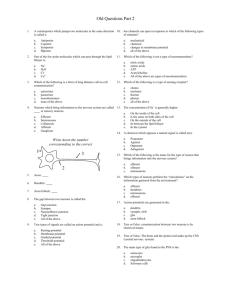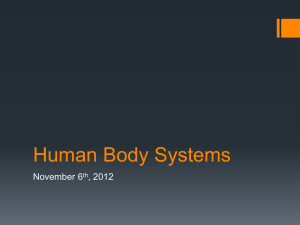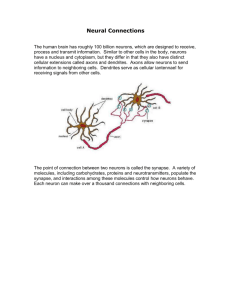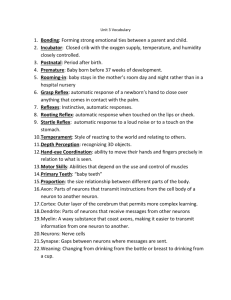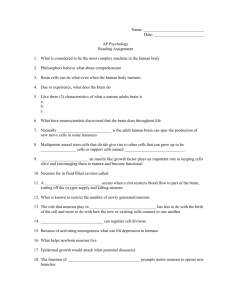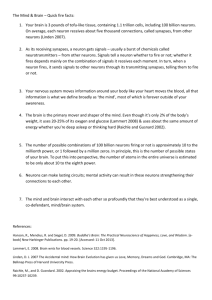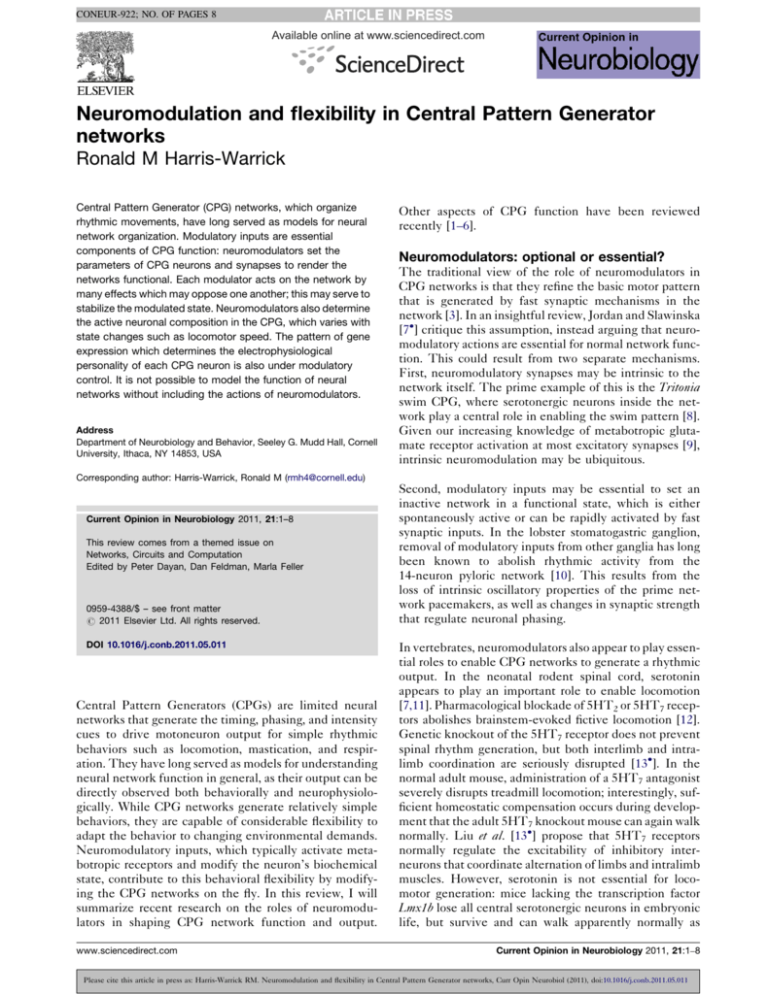
CONEUR-922; NO. OF PAGES 8
Available online at www.sciencedirect.com
Neuromodulation and flexibility in Central Pattern Generator
networks
Ronald M Harris-Warrick
Central Pattern Generator (CPG) networks, which organize
rhythmic movements, have long served as models for neural
network organization. Modulatory inputs are essential
components of CPG function: neuromodulators set the
parameters of CPG neurons and synapses to render the
networks functional. Each modulator acts on the network by
many effects which may oppose one another; this may serve to
stabilize the modulated state. Neuromodulators also determine
the active neuronal composition in the CPG, which varies with
state changes such as locomotor speed. The pattern of gene
expression which determines the electrophysiological
personality of each CPG neuron is also under modulatory
control. It is not possible to model the function of neural
networks without including the actions of neuromodulators.
Address
Department of Neurobiology and Behavior, Seeley G. Mudd Hall, Cornell
University, Ithaca, NY 14853, USA
Other aspects of CPG function have been reviewed
recently [1–6].
Neuromodulators: optional or essential?
The traditional view of the role of neuromodulators in
CPG networks is that they refine the basic motor pattern
that is generated by fast synaptic mechanisms in the
network [3]. In an insightful review, Jordan and Slawinska
[7] critique this assumption, instead arguing that neuromodulatory actions are essential for normal network function. This could result from two separate mechanisms.
First, neuromodulatory synapses may be intrinsic to the
network itself. The prime example of this is the Tritonia
swim CPG, where serotonergic neurons inside the network play a central role in enabling the swim pattern [8].
Given our increasing knowledge of metabotropic glutamate receptor activation at most excitatory synapses [9],
intrinsic neuromodulation may be ubiquitous.
Corresponding author: Harris-Warrick, Ronald M (rmh4@cornell.edu)
Current Opinion in Neurobiology 2011, 21:1–8
This review comes from a themed issue on
Networks, Circuits and Computation
Edited by Peter Dayan, Dan Feldman, Marla Feller
0959-4388/$ – see front matter
# 2011 Elsevier Ltd. All rights reserved.
DOI 10.1016/j.conb.2011.05.011
Central Pattern Generators (CPGs) are limited neural
networks that generate the timing, phasing, and intensity
cues to drive motoneuron output for simple rhythmic
behaviors such as locomotion, mastication, and respiration. They have long served as models for understanding
neural network function in general, as their output can be
directly observed both behaviorally and neurophysiologically. While CPG networks generate relatively simple
behaviors, they are capable of considerable flexibility to
adapt the behavior to changing environmental demands.
Neuromodulatory inputs, which typically activate metabotropic receptors and modify the neuron’s biochemical
state, contribute to this behavioral flexibility by modifying the CPG networks on the fly. In this review, I will
summarize recent research on the roles of neuromodulators in shaping CPG network function and output.
www.sciencedirect.com
Second, modulatory inputs may be essential to set an
inactive network in a functional state, which is either
spontaneously active or can be rapidly activated by fast
synaptic inputs. In the lobster stomatogastric ganglion,
removal of modulatory inputs from other ganglia has long
been known to abolish rhythmic activity from the
14-neuron pyloric network [10]. This results from the
loss of intrinsic oscillatory properties of the prime network pacemakers, as well as changes in synaptic strength
that regulate neuronal phasing.
In vertebrates, neuromodulators also appear to play essential roles to enable CPG networks to generate a rhythmic
output. In the neonatal rodent spinal cord, serotonin
appears to play an important role to enable locomotion
[7,11]. Pharmacological blockade of 5HT2 or 5HT7 receptors abolishes brainstem-evoked fictive locomotion [12].
Genetic knockout of the 5HT7 receptor does not prevent
spinal rhythm generation, but both interlimb and intralimb coordination are seriously disrupted [13]. In the
normal adult mouse, administration of a 5HT7 antagonist
severely disrupts treadmill locomotion; interestingly, sufficient homeostatic compensation occurs during development that the adult 5HT7 knockout mouse can again walk
normally. Liu et al. [13] propose that 5HT7 receptors
normally regulate the excitability of inhibitory interneurons that coordinate alternation of limbs and intralimb
muscles. However, serotonin is not essential for locomotor generation: mice lacking the transcription factor
Lmx1b lose all central serotonergic neurons in embryonic
life, but survive and can walk apparently normally as
Current Opinion in Neurobiology 2011, 21:1–8
Please cite this article in press as: Harris-Warrick RM. Neuromodulation and flexibility in Central Pattern Generator networks, Curr Opin Neurobiol (2011), doi:10.1016/j.conb.2011.05.011
CONEUR-922; NO. OF PAGES 8
2 Networks, Circuits and Computation
adults [14]. Detailed tests of locomotor coordination have
not been carried out on these mice. While it is not clear
how these animals walk in the absence of serotonin, it is
possible that compensatory mechanisms are activated
during development so that other modulatory inputs,
for example, using norepinephrine, dopamine (DA) or
other transmitters, can help generate locomotion.
Serotonin and other neuromodulators also play critical
roles in the neonatal mouse medullary respiratory CPG
[15]. In vitro, antagonists of serotonin and/or Substance P
receptors abolish the respiratory rhythm [16,17]. Neonatal
mice genetically engineered to lack 5HT neurons show
severe and prolonged episodes of apnea, and many of
them die around birth, but can be rescued by 5HT2A
agonists. Animals which survive the perinatal period
recover normal respiration by P14 [17]. However, 5HT
is not the only modulator to support neonatal respiration;
the relative roles of the different modulators change with
the state of the system. Doi and Ramirez [18] studied the
roles of endogenously released serotonin, norepinephrine
and Substance P in vitro and in vivo. Substance P can
accelerate respiratory rate, but only if the respiratory rate
is low or there is low 5HT and NE activity. If these are
elevated by stimulating the raphe nuclei or locus coeruleus, there is no additional effect of Substance P. Thus,
the modulatory effects of these compounds depend critically upon the state of the system.
Opposing actions of a neuromodulator
stabilize the modified state of the network
While a neuromodulator may alter a network’s output in a
certain direction (e.g. strengthening the output or accelerating the rhythm), its cellular actions may not all be
aimed in that direction, and some of them may be
opposing (e.g. to weaken the output or slow the rhythm).
Given the somewhat nonspecific second messenger
mechanisms activated by a neuromodulator (e.g.
increases in cAMP can modify the properties of many
proteins), opposing actions are expected, and may play
important regulatory roles. Simple CPG networks provide
a unique opportunity to study opposing actions of neuromodulators at the level of a single identified neuron or
synapse. The cellular, ionic, and synaptic mechanisms by
which DA reconfigures the 14-neuron pyloric network
have been systematically explored [19]. At a number of
sites, DA evokes responses that oppose its overall actions
on pyloric neurons and synapses (Figure 1). For example,
DA hyperpolarizes and silences one neuron, but simultaneously enhances its hyperpolarization-activated
inward current, Ih, which would depolarize the neuron
to resume firing. DA increases spike frequency in several
neurons but enhances a slowly activating potassium current that would reduce spike frequency. DA can also
activate opposing effects at a single synapse. For
example, it can enhance transmitter release from the
presynaptic terminal by increasing calcium currents,
Current Opinion in Neurobiology 2011, 21:1–8
but reduce postsynaptic responsiveness to the released
transmitter. In the neonatal mouse spinal cord, mGluR1
agonists weaken motoneuron activity during fictive locomotion, and reduce spiking responses to depolarizing
steps by reducing the fast sodium current. However, at
the same time they depolarize motoneurons by enhancing
a nonselective cation current, and hyperpolarize the spike
threshold, actions which would enhance motoneuron
firing [20]. Levitan and colleagues showed that serotonin
and the peptide egg-laying hormone (ELH) both activate
opposing currents in the Aplysia burster neuron R15,
which can either slow burst frequency or evoke bistable
firing [21]. These actions are activated at different concentrations of the modulators, allowing a frequency-dependent switch in modulator activity regulating R15
bursting.
We have considered four reasons why such opposing
neuromodulatory effects have been retained during
evolution [19]. First, they could reflect the nonspecific
second messenger mechanisms activated by the neuromodulator; as long as the ‘preferred’ effects predominate, the minor ‘nonpreferred’ effects may be ignored.
Second, they could allow the sign of the modulator’s
effect to reverse depending on the state of the system,
for example, when other neuromodulators block one set
of the modulator’s actions. Third, they may be activated with different concentration dependence or
kinetics, allowing complex multi-component responses
in the cell [21]. Finally, they could provide a system of
checks and balances that constrain the degree of flexibility of the network, preventing it from going into a
nonfunctional ‘over-modulated’ state. The opposing
actions could then serve as ‘brakes’ to regulate the
degree of modulation of the system. While the
examples given here come primarily from CPG studies,
opposing actions of neuromodulators could in theory
stabilize neuronal activity in many kinds of circuits in
the nervous system.
Regulation of CPG neuronal composition
It is often assumed that the neuronal composition of a
CPG network is fixed, but the neurons participating in the
network vary continuously with the state of the system.
Different neuromodulators activate and inhibit unique
subsets of STG pyloric neurons so that the active circuit
varies with the modulatory state [22]. In rodents, the
medullary respiratory circuit is dynamically reconfigured
during normal respiration (eupnea), sighs, and gasping.
Sighs and eupnea, for example, depend on different ionic
currents expressed on different neurons, to provide the
rhythmic drive for breathing. Sigh behavior depends
critically on synaptic mechanisms driven by P/Q type
calcium currents which innervate only a small subset of
pre-Bötzinger complex neurons [23]. Eupnea does not
depend strongly on these pathways, but on NMDA-dependent synaptic mechanisms. Thus, an overlapping but
www.sciencedirect.com
Please cite this article in press as: Harris-Warrick RM. Neuromodulation and flexibility in Central Pattern Generator networks, Curr Opin Neurobiol (2011), doi:10.1016/j.conb.2011.05.011
CONEUR-922; NO. OF PAGES 8
Prefer Central Pattern Generator Modulation Harris-Warrick 3
Figure 1
(a)
(b)
Control
DA
AB
AB
PD
PD
LP
LP
PY
PY
500 ms
(d)
(c)
A
Ca
h
Response to glutamate iontophoresis
+
A
PY
-8-
PY
+
LP
Ca
K(V)
Ca
A
h Na(p)
?
Rin change
with DA
+
AB
+
A K(Ca)
PD
-
Leak
+
+- +
Ca
LP
+
VD
Ca
IC
+
VD
0
?
-
Change in calcium
accumulation
-
A
?
-
K(V)
IC
+
-
Ca
PD
-2-
AB
+
+-
h
h
Current Opinion in Neurobiology
Positive and negative effects of neuromodulators in a CPG network. (a) Simultaneous recordings from four neurons in the pyloric network of the lobster
stomatogastric ganglion, showing the rhythmic pattern under normal conditions of modulatory inputs. AB: anterior burster; PD: pyloric dilator; LP:
lateral pyloric; PY: pyloric constrictor. (b) Changes in the pyloric motor pattern when dopamine (10 4 M) is added. The AB, LP and PY neurons are all
excited and fire more strongly while the PD is inhibited and fires weakly or not at all. There are also significant phasing changes. (c) Wiring diagram of
the pyloric network, showing the effects of dopamine on ionic currents. Inhibitory synapses are drawn with filled circles; non-rectifying electrical
synapses are drawn with a resistor, while rectifying synapses are drawn with a diode symbol indicating the direction of preferred current flow. Neurons
in green are excited by dopamine, while those in red are inhibited. Dopamine evokes different changes in ionic currents in each of the neurons.
Modulated currents in red would cause opposite effects on neuronal firing than the overall effect of dopamine. (d) Summary of dopamine’s effects on
synaptic transmission in the pyloric network. Strengthened and weakened synapses are shown with thick and dashed lines, respectively. Some
electrical synapses show opposite responses to dopamine depending on the direction of current flow, indicated by synapses that are partly bold and
partly dashed. Plus and minus symbols in nerve terminals reflect changes in voltage-activated presynaptic calcium accumulation during dopamine.
Pipette symbols with plus and minus symbols indicate changes in postsynaptic responsiveness to iontophoresed glutamate, the transmitter of most of
the pyloric neurons. Circled plus and minus symbols in the cell bodies indicate dopamine’s effect on postsynaptic input resistance. Red-circled
synapses are those where the presynaptic effects of dopamine are of opposing sign to its postsynaptic effects. Modified from Ref. [19].
nonidentical pool of neurons generates these different
respiratory modes [15]. Gasping is evoked by hypoxia; as
respiration slows and becomes stronger, many expiratory
and inspiratory ventrolateral neurons fall silent. In the
pre-Bötzinger complex, during eupnea, rhythm generation depends on neurons expressing both calcium-activated nonselective currents and persistent sodium
currents [24,25]. During gasping, the pattern depends
most strongly on the subset of neurons that express INaP
[26]. Neuromodulators play critical roles in all these
transitions; their effects are complex and state-dependent, and redundancy has been built into this essential
system to retain respiration under nearly all conditions
[15].
www.sciencedirect.com
In the vertebrate spinal cord, many interneurons are
multifunctional, participating in different behaviors
[27]. In the turtle spinal cord, some interneurons participate in both swimming and scratching, while others are
active only during scratching and are inhibited during
swimming. In the larval zebrafish, different components
of the swim CPG are active during swimming, escape
behavior and struggling. Different glycinergic commissural interneurons show variable multifunctionality
during these behaviors [28]. The commissural bifurcating
longitudinal neurons (CoBLs) and commissural secondary ascending interneurons (CoSAs) are multifunctional,
being strongly active during swimming and most struggling episodes, and sometimes during escape swims. On
Current Opinion in Neurobiology 2011, 21:1–8
Please cite this article in press as: Harris-Warrick RM. Neuromodulation and flexibility in Central Pattern Generator networks, Curr Opin Neurobiol (2011), doi:10.1016/j.conb.2011.05.011
CONEUR-922; NO. OF PAGES 8
4 Networks, Circuits and Computation
Figure 2
(a)
Dorsal CiD cell
mV
–20
12
Percentage firing
100
0
80
60
40
20
20 μm
0
0
(b)
Ventral CiD cell
20
40
60
80 100
40
60
80 100
0
mV
–20
12
Percentage firing
100
80
60
40
20
0
20 μm
0
20 ms
20
Swim frequency, Hz
(c)
Intermediate
Slowest
MN
V0
CiD
Fastest
MN
V0
CiD
X
MN
V0
X
CiD
X
Active
Silent
X Inhibited
Current Opinion in Neurobiology
Speed-dependent locomotor recruitment and inhibition of V2a interneurons in the zebrafish spinal cord. The CiD interneurons show a ventrodorsal
gradient of activity at different speeds during locomotion. (a) Dorsal CiD is activated at the beginning of a swim bout, when the cycle frequency is
highest, and is inactive at lower frequencies later in the swim bout. The recordings in the middle show the intracellular recording from the CiD (top) and
an extracellular recording from a motor nerve to monitor the swim frequency (bottom). The histogram at right shows the percentage of dorsal CiDs
active at different swim frequencies. (b) Ventral CiD is silent and actively inhibited at the highest frequencies at the beginning of the swim bout, but is
activated at lower swim frequencies. Histogram at right shows that ventral CiDs are active at lower frequencies than the dorsal CiD neurons. Modified
from Ref. [29]. (c) Summary diagram of the recruitment of interneurons at different swim speeds in the larval zebrafish. Modified from Ref. [53].
the other hand, the commissural longitudinal ascending
interneurons (CoLA) and commissural local interneurons
(CoLos) are specialized, being active only during slow
struggling movements and escape swims, respectively.
The neuronal composition of locomotor CPG networks
also changes markedly with changes in locomotor speed.
In the zebrafish, the circumferential descending interneurons (CiDs) show a dorsoventral gradient of activity at
different speeds: ventral CiDs are active at lower frequencies but are inhibited at higher frequencies, while
dorsal CiDs are silent at lower frequencies and are
recruited at higher frequencies (Figure 2) [29]. In the
mouse spinal cord, the V2a neurons express the same
transcription factor as the CiDs (alx in zebrafish, Chx10 in
mice). The V2a neurons also change their activity with
Current Opinion in Neurobiology 2011, 21:1–8
speed, being less active at lower speeds and increasingly
recruited and more active at higher speeds [30]. Genetic
deletion of the V2a interneurons shows that they play a
crucial role in regulating left-right limb alternation, but
only at high speeds [31,32]. Clearly, the relative role of
these neurons during locomotion varies as a function of
speed from zebrafish to mouse.
The neural mechanisms encoding the selective recruitment and silencing of neurons at different speeds of
locomotion are not well understood, but neuromodulatory
inputs can play a role. In the mouse [20], Xenopus tadpole
[33] and lamprey [34], group I metabotropic glutamate
receptor agonists accelerate the locomotor rhythm from
the isolated spinal cord, via combinations of synaptic and
intrinsic neuronal mechanisms. Serotonin slows the
www.sciencedirect.com
Please cite this article in press as: Harris-Warrick RM. Neuromodulation and flexibility in Central Pattern Generator networks, Curr Opin Neurobiol (2011), doi:10.1016/j.conb.2011.05.011
CONEUR-922; NO. OF PAGES 8
Prefer Central Pattern Generator Modulation Harris-Warrick 5
ongoing fictive locomotor rhythm in lamprey [35] and
mouse [36,37] spinal cords, but increases locomotor frequency in the Xenopus spinal cord [38]. These modulatory
effects must act on CPG interneurons, but little is known
about their interneuronal targets. In the neonatal mouse
spinal cord, serotonin excites V2a interneurons, depolarizing them, increasing their input resistance and enhancing their f/I responses [39], excites commissural
interneurons in part by reducing ICa and consequently
IK(Ca) [40–42], and excites unidentified locomotor interneurons in part by enhancing Ih and persistent inward
currents [43,44].
of genes for ion channels, pumps and receptors. Recent
work in the crustacean STG has addressed this issue.
MacLean et al. [45,46] showed that expression of the
transient potassium current, IA and the inward current Ih
is coregulated in a constant ratio in PD neurons, despite
varying absolute levels of each current in different PD
neurons. Modeling confirmed the surprising result that as
long as the ratio of IA to Ih remains constant, the firing
properties of the neurons remain constant. Schulz et al.
[47] extended these data by showing that several pairs of
ionic currents showed a constant ratio of gene expression
in single STG neurons (Figure 3). Neuron types differed
both in which channel gene pairs showed a constant RNA
ratio, and in the slopes of the relationships. Recent work
showed that different neuron types also showed different
patterns of alternative splicing of RNA for the voltagedependent sodium channel, providing another path to
neuron specification [48]. Thus, the electrophysiological
identity of STG neurons is partially determined by their
Neuromodulator control of ionic current
expression and neuronal identity
For any network to function, the component neurons
must develop and maintain the specific electrical properties that define them as a particular neuron type. Electrical activity is determined by the pattern of expression
Figure 3
(a)
(b)
(c)
GM
IC
LG
LP
PD
20000
a
10000
0
2000
400
800
1200
IH mRNA
1600
2000
1000
leak
a
+
shab mRNA
BKKCa mRNA
30000
20000
shal mRNA
1600
Key
400
shaw mRNA
shab mRNA
b
400
800
1200
IH mRNA
1600
2000
B
17
f
9.6
A
+ -
KCa
A
KCa
b
2000
Burst duration
0.5-0.75 sec
2000
CaT
-
13
+
+
Kd
+
leak
+
+
KCa - + Kd +
+
CaS
KCa
+
+
leak
0
Na
CaT
+
Burst Period
1-2 sec
200 400
4
A
KCa
600 800 1000 1200 1400
shab mRNA
+ -
A
+
-
Slow wave
amplitude
10-30 mV
6.4
KCa
Kd
leak
Na
CaT
CaS
CaS
0
1000
1500
IH mRNA
A
Na
+
A
leak
3000
1000
500
CaT
CaS
6.3
+
Kd
Kd
a
9.3
0
leak
Na
+
- -
CaT
CaS
4000
800
Kd
+
Na
+
CaS
leak
1200
A
KCa
+
leak
Na
5000
5000
a
+
+
+
- + +
+ +
CaS
32
KCa
Kd
leak
0
40000
A
CaT
b
CaT
10000
CaS
9.6
A
Kd
10000
0
Na
+
- -
CaT
CaS
4.5
KCa
500
Na
CaT
15000
1000
leak
Na
5000 10000 15000 20000 25000 30000
BKKCa mRNA
20000
1500
+
+ -
Kd
c
0
2000
KCa
Kd
3000
A
+
KCa
b
4000
CaS
35
A
4.5
5000
c
c
b
a a
CaS
a
6000
b
CaT
CaT
7000
para mRNA
shal mRNA
30000
Na
Na
Key:
-
+
+
Na
Slow wave peak
-55 to -25
CaT +
mV
CaS
4.5
KCa
Kd
Kd
leak
A
Na
CaT
CaS
+
leak
+
+ +
Kd
leak
CaT
CaS
4.2
A
KCa
Na
Duty cycle
0.3-0.4
-
+
A
KCa
+
Kd
- +
-
+
leak
Current Opinion in Neurobiology
Ionic current pair coregulation helps to define identities of neurons. (a) Variations in RNA expression levels in single identified neurons from the lobster
stomatogastric ganglion. Each graph shows the relationship between the number of copies of RNA for two ion channel genes, measured in multiple
copies of a number of different identified neurons. The lines show the average slope of the relationship. Note that no neuron type has a linear
relationship between all the current pairs shown; different neurons show different subsets of relationships. Note also that the slope of the current
relationship can differ strongly between neurons. This helps define the electrophysiological properties of each neuron type. From Ref. [47]. (b)
Modeling the relationship between levels of expression of the slow calcium current, gCaS and the calcium-activated potassium current, gKCa, in a
database of bursting neuron models. Each current’s maximal conductance was allowed to vary over six values, shown on the axes. The database was
polled to determine the current levels in many bursting models with duty cycles between 0.1 and 0.2. The color code shows the numbers of models
with each correlation; clearly there is a linear relationship between these currents, similar to those found experimentally in (a). (c) Variation in the current
correlations in bursting models as the criteria for inclusion are sequentially restricted. Bottom row: Grey boxes show the correlations between currents
in the database models of bursting with the indicated parameters. Then pairs of parameters are combined to identify model neurons that combine both
of the lower parameters. This process is repeated going up the figure. At each level, the correlations found in the parent pairs are shown in grey boxes,
and if they are blank, there is no correlation at the next level. This shows that as the selected set becomes increasingly constrained by multiple
parameters, the numbers of ion channel correlations change in unexpected ways, but typically decrease. (b) and (c) from Ref. [49].
www.sciencedirect.com
Current Opinion in Neurobiology 2011, 21:1–8
Please cite this article in press as: Harris-Warrick RM. Neuromodulation and flexibility in Central Pattern Generator networks, Curr Opin Neurobiol (2011), doi:10.1016/j.conb.2011.05.011
CONEUR-922; NO. OF PAGES 8
6 Networks, Circuits and Computation
unique ratios and types of coregulated ion channel
expression. Hudson and Prinz [49] modeled these results
by classifying the activity patterns in a large database of
all possible neurons based on a generic STG neuron
model with eight variable ionic conductances. When
separated by class of firing properties (bursting, tonic,
etc.), class-specific sets of correlations between pairs of
ionic currents were seen. In general, when more constraints were placed on the neuron classification by requiring multiple parameters within limited ranges, the
numbers and types of current correlations changed, sometimes in unexpected ways, but typically to reduce the
total number of correlations (Figure 3). Two kinds of
correlations were found in the models which have not yet
been observed experimentally: correlations involving
calcium currents (which are difficult to measure in
STG neurons), and negative correlations between currents, which have never been seen experimentally but
represent 30% of the correlations in the model. This
model will certainly focus future experimental research
towards these two correlations.
This ion current coregulation depends in part on modulatory input to the STG. Khorkova and Golowasch [50]
studied the changes in ionic currents following decentralization to remove all modulatory inputs to the STG.
Pyloric neurons immediately stop oscillating, but over a
period of days they resume oscillating [51]. Removal of
descending modulatory input changed the levels of several ionic currents in the PD neuron, and eliminated most
of the fixed current ratios. The peptide proctolin was able
to prevent these changes and maintain the normal current
ratios, even in the presence of TTX, showing that this was
not due to an activity-dependent mechanism. Zhang et al.
[52] recently showed that activity and neuromodulation
both contribute in the initial phase of recovery from
removal of inputs, though in different ways. A model
with two independent mechanisms for recovery after
decentralization adequately reproduced these results.
The activity-dependent component used an intracellular
sensor regulated by intracellular calcium, with inverse
effects on the membrane calcium conductance and the
intracellular calcium pump activity. The activity-independent modulator component directly enhances calcium
currents. With appropriate kinetics, these models reproduced the physiological results, resulting in a different set
of currents driving the oscillations before and after recovery from decentralization [52].
Conclusion
Several major conclusions can be drawn from our analysis
of flexibility in CPG networks. First, the idea that modulatory inputs are optional modifiers that fine-tune
ongoing CPG function should be discarded. We predict
that all CPG networks will require some modulatory
input to coalesce into functional circuits, through a combination of intrinsic and extrinsic modulatory actions.
Current Opinion in Neurobiology 2011, 21:1–8
Second, neuromodulators can exert both positive and
negative effects on a particular neuron or synapse; such
opposing actions could provide added flexibility and
constraints to regulate CPG activity within its functional
parameter space. Third, CPGs should be conceptualized
as having a flexible composition: the neurons participating in the network and the strengths of their synaptic
connections are highly variable; some neurons may only
play a role in a particular state (developmental, speed, and
environmental). Finally neuromodulators play essential
roles to maintain the ionic currents that determine the
identity of CPG neurons and their synapses. Future
modeling studies should take modulatory inputs and
actions into account in developing new concepts for
the generation of behavioral flexibility.
Acknowledgements
The work in our lab is supported by NIH grants NS17323 and NS057599,
and NSF grant IOS-0749467.
References and recommended reading
Papers of particular interest, published within the period of review,
have been highlighted as:
of special interest
of outstanding interest
1.
Dickinson PS: Neuromodulation of central pattern generators
in invertebrates and vertebrates. Curr Opin Neurobiol 2006,
16:604-614.
2.
Jordan LM, Liu J, Hedlund PB, Akay T, Pearson KG: Descending
command systems for the initiation of locomotion in
mammals. Brain Res Rev 2008, 57:183-191.
3.
Grillner S, Jessell TM: Measured motion: searching for
simplicity in spinal locomotor networks. Curr Opin Neurobiol
2009, 19:572-586.
4.
Goulding M: Circuits controlling vertebrate locomotion:
moving in a new direction. Nat Rev Neurosci 2009, 10:507-518.
5.
Roberts A, Li WC, Soffe SR: How neurons generate behavior in a
hatchling amphibian tadpole: an outline. Front Behav Neurosci
2010, 4:16.
6.
Selverston AI: Invertebrate central pattern generator circuits.
Philos Trans R Soc Lond B Biol Sci 2010, 365:2329-2345.
7. Jordan LM, Slawinska U: Modulation of rhythmic movement:
control of coordination. Prog Brain Res 2011, 188:181-195.
An insightful review of the actions of neuromodulators in the CPGs
controlling locomotion, respiration and mastication.
8.
Katz PS: Intrinsic and extrinsic neuromodulation of motor
circuits. Curr Opin Neurobiol 1995, 5:799-808.
9.
Knopfel T, Uusisaari M: Modulation of excitation by
metabotropic glutamate receptors. Results Probl Cell Differ
2008, 44:163-175.
10. Russell DF, Hartline DK: Bursting neural networks: a
reexamination. Science 1978, 200:453-456.
11. Schmidt BJ, Jordan LM: The role of serotonin in reflex
modulation and locomotor rhythm production in the
mammalian spinal cord. Brain Res Bull 2000, 53:689-710.
12. Jordan LM, Schmidt BJ: Propriospinal neurons involved in the
control of locomotion: potential targets for repair strategies?
Prog Brain Res 2002, 137:125-139.
13. Liu J, Akay T, Hedlund PB, Pearson KG, Jordan LM: Spinal 5-HT7
receptors are critical for alternating activity during
locomotion: in vitro neonatal and in vivo adult studies using 5HT7 receptor knockout mice. J Neurophysiol 2009, 102:337-348.
www.sciencedirect.com
Please cite this article in press as: Harris-Warrick RM. Neuromodulation and flexibility in Central Pattern Generator networks, Curr Opin Neurobiol (2011), doi:10.1016/j.conb.2011.05.011
CONEUR-922; NO. OF PAGES 8
Prefer Central Pattern Generator Modulation Harris-Warrick 7
Shows that genetic deletion of 5-HT7 receptors disrupts left-right and
unilateral flexor-extensor alternation while still allowing rhythmc generation. Suggests that these receptors control activity of inhibitory interneurons responsible for limb and muscle coordination.
14. Zhao ZQ, Scott M, Chiechio S, Wang JS, Renner KJ, Gereau RWt,
Johnson RL, Deneris ES, Chen ZF: Lmx1b is required for
maintenance of central serotonergic neurons and mice
lacking central serotonergic system exhibit normal locomotor
activity. J Neurosci 2006, 26:12781-12788.
15. Garcia AJ 3rd, Zanella S, Koch H, Doi A, Ramirez JM: Chapter 3—
networks within networks: the neuronal control of breathing.
Prog Brain Res 2011, 188:31-50.
16. Pena F, Ramirez JM: Endogenous activation of serotonin-2a
receptors is required for respiratory rhythm generation in
vitro. J Neurosci 2002, 22:11055-11064.
17. Hodges MR, Wehner M, Aungst J, Smith JC, Richerson GB:
Transgenic mice lacking serotonin neurons have severe
apnea and high mortality during development. J Neurosci 2009,
29:10341-10349.
18. Doi A, Ramirez JM: State-dependent interactions between
excitatory neuromodulators in the neuronal control of
breathing. J Neurosci 2010, 30:8251-8262.
Studies the interactions between Substance P, serotonin and norepinephrine on the respiratory CPG; Substance P only affects respiratory
frequency under conditions of low serotonin and norepinephrine activity.
19. Harris-Warrick RM, Johnson BR: Checks and balances in
neuromodulation. Front Behav Neurosci 2010, 4:47.
Catalogs the multiple and sometimes opposing effects of dopamine on
the pyloric network in the stomatogastric ganglion, and proposes possible uses of these opposing actions.
20. Iwagaki N, Miles GB: Activation of group i metabotropic
glutamate receptors modulates locomotor-related
motoneuron output in mice. J Neurophysiol 2011. [Epub ahead
of print].
Analyzes the multiple and opposing actions of mGluR1 receptor action on
mouse spinal motoneurons.
21. Levitan ES, Kramer RH, Levitan IB: Augmentation of bursting
pacemaker activity by egg-laying hormone in aplysia neuron
r15 is mediated by a cyclic amp-dependent increase in ca2+
and k+ currents. Proc Natl Acad Sci U S A 1987, 84:6307-6311.
22. Marder E, Bucher D: Understanding circuit dynamics using the
stomatogastric nervous system of lobsters and crabs. Annu
Rev Physiol 2007, 69:291-316.
23. Lieske SP, Ramirez JM: Pattern-specific synaptic mechanisms
in a multifunctional network. I. Effects of alterations in
synapse strength. J Neurophysiol 2006, 95:1323-1333.
24. Dunmyre JR, Del Negro CA, Rubin JE: Interactions of persistent
sodium and calcium-activated nonspecific cationic currents
yield dynamically distinct bursting regimes in a model of
respiratory neurons. J Comput Neurosci 2011. [Epub ahead of
print].
A model of pre-Bötzinger complex neurons shows that systematic variation of INaP and ICAN can generate a variety of firing intrinsic firing patterns
similar to those seen in electrophysiological recordings.
25. Pena F, Parkis MA, Tryba AK, Ramirez JM: Differential
contribution of pacemaker properties to the generation of
respiratory rhythms during normoxia and hypoxia. Neuron
2004, 43:105-117.
26. Paton JF, Abdala AP, Koizumi H, Smith JC, St-John WM:
Respiratory rhythm generation during gasping depends on
persistent sodium current. Nat Neurosci 2006, 9:311-313.
27. Berkowitz A, Roberts A, Soffe SR: Roles for multifunctional and
specialized spinal interneurons during motor pattern
generation in tadpoles, zebrafish larvae, and turtles. Front
Behav Neurosci 2010, 4:36.
28. Liao JC, Fetcho JR: Shared versus specialized glycinergic
spinal interneurons in axial motor circuits of larval zebrafish.
J Neurosci 2008, 28:12982-12992.
29. McLean DL, Masino MA, Koh IY, Lindquist WB, Fetcho JR:
Continuous shifts in the active set of spinal interneurons
www.sciencedirect.com
during changes in locomotor speed. Nat Neurosci 2008,
11:1419-1429.
The CiD interneurons show a dorsoventral gradient in input resistance
and activation during fictive locomotion. The higher resistance ventral
CiDs are activated at low swim frequencies but inhibited at higher
frequencies, whilc the lower resistance dorsal CiDs show the opposite
pattern. This shows that the neuronal composition of the CPG varies with
swim frequency.
30. Zhong G, Sharma K, Harris-Warrick RM: Frequency-dependent
recruitment of v2a interneurons during fictive locomotion in
the mouse spinal cord. Nat Commun 2011 http://dx.doi.org/
10.1038/ncomms1276.
31. Crone SA, Quinlan KA, Zagoraiou L, Droho S, Restrepo CE,
Lundfald L, Endo T, Setlak J, Jessell TM, Kiehn O, Sharma K:
Genetic ablation of v2a ipsilateral interneurons disrupts leftright locomotor coordination in mammalian spinal cord.
Neuron 2008, 60:70-83.
32. Crone SA, Zhong G, Harris-Warrick R, Sharma K: In mice lacking
v2a interneurons, gait depends on speed of locomotion. J
Neurosci 2009, 29:7098-7109.
33. Chapman RJ, Issberner JP, Sillar KT: Group i mglurs increase
locomotor network excitability in xenopus tadpoles via
presynaptic inhibition of glycinergic neurotransmission. Eur J
Neurosci 2008, 28:903-913.
34. Kyriakatos A, El Manira A: Long-term plasticity of the spinal
locomotor circuitry mediated by endocannabinoid and nitric
oxide signaling. J Neurosci 2007,
27:12664-12674.
35. Harris-Warrick RM, Cohen AH: Serotonin modulates the central
pattern generator for locomotion in the isolated lamprey
spinal cord. J Exp Biol 1985, 116:27-46.
36. Gordon IT, Whelan PJ: Monoaminergic control of caudaequina-evoked locomotion in the neonatal mouse spinal cord.
J Neurophysiol 2006, 96:3122-3129.
37. Dunbar MJ, Tran MA, Whelan PJ: Endogenous extracellular
serotonin modulates the spinal locomotor network of the
neonatal mouse. J Physiol 2010, 588:139-156.
38. Sillar KT, Reith CA, McDearmid JR: Development and aminergic
neuromodulation of a spinal locomotor network controlling
swimming in xenopus larvae. Ann N Y Acad Sci 1998,
860:318-332.
39. Zhong G, Droho S, Crone SA, Dietz S, Kwan AC, Webb WW,
Sharma K, Harris-Warrick RM: Electrophysiological
characterization of v2a interneurons and their locomotorrelated activity in the neonatal mouse spinal cord. J Neurosci
2010, 30:170-182.
40. Zhong G, Diaz-Rios ME, Harris-Warrick RM: Serotonin
modulates the properties of ascending commissural
interneurons in the neonatal mouse spinal cord. J Neurophysiol
2006, 95:1545-1555.
41. Zhong G, Diaz-Rios M, Harris-Warrick RM: Intrinsic and
functional differences among commissural interneurons
during fictive locomotion and serotonergic modulation in the
neonatal mouse. J Neurosci 2006, 26:6509-6517.
42. Carlin KP, Dai Y, Jordan LM: Cholinergic and serotonergic
excitation of ascending commissural neurons in the thoracolumbar spinal cord of the neonatal mouse. J Neurophysiol 2006,
95:1278-1284.
43. Dai Y, Jordan LM: Multiple patterns and components of
persistent inward current with serotonergic modulation in
locomotor activity-related neurons in cfos-egfp mice.
J Neurophysiol 2010, 103:1712-1727.
Using activity-dependent GFP labeling, this study shows that locomotoractivated interneurons possess both sodium- and calcium-mediated
persistent inwards currents, and that these are enhanced in several ways
by serotonin.
44. Dai Y, Jordan LM: Multiple effects of serotonin and
acetylcholine on hyperpolarization-activated inward current in
locomotor activity-related neurons in cfos-egfp mice.
J Neurophysiol 2010, 104:366-381.
Current Opinion in Neurobiology 2011, 21:1–8
Please cite this article in press as: Harris-Warrick RM. Neuromodulation and flexibility in Central Pattern Generator networks, Curr Opin Neurobiol (2011), doi:10.1016/j.conb.2011.05.011
CONEUR-922; NO. OF PAGES 8
8 Networks, Circuits and Computation
45. MacLean JN, Zhang Y, Johnson BR, Harris-Warrick RM: Activityindependent homeostasis in rhythmically active neurons.
Neuron 2003, 37:109-120.
46. MacLean JN, Zhang Y, Goeritz ML, Casey R, Oliva R,
Guckenheimer J, Harris-Warrick RM: Activity-independent
coregulation of ia and ih in rhythmically active neurons.
J Neurophysiol 2005, 94:3601-3617.
47. Schulz DJ, Goaillard JM, Marder EE: Quantitative expression
profiling of identified neurons reveals cell-specific constraints
on highly variable levels of gene expression. Proc Natl Acad Sci
U S A 2007, 104:13187-13191.
48. Dai A, Temporal S, Shulz DJ: Cell-specific patterns of alternative
splicing of voltage-gated ion channels in single identified
neurons. Neuroscience 2010, 168:118-129.
49. Hudson AE, Prinz AA: Conductance ratios and cellular identity.
PLoS Comput Biol 2010, 6:e1000838 doi: 10.1371/
journal.pcbi.1000838.
Analysis of 1 679 616 variants of a stomatogastric ganglion neuron model
shows that correlations between expression of pairs of ionic currents are
Current Opinion in Neurobiology 2011, 21:1–8
frequent within classes of firing patterns, especially when increasing
constraints are placed on specification of the activity classes. These
correlations vary by class. Both positive and negative correlations are
seen in the model, though only positive correlations have been seen
experimentally
50. Khorkova O, Golowasch J: Neuromodulators, not activity,
control coordinated expression of ionic currents. J Neurosci
2007, 27:8709-8718.
51. Thoby-Brisson M, Simmers J: Neuromodulatory inputs maintain
expression of a lobster motor pattern generating network in a
modulation-dependent state: evidence from long-term
decentralization in vitro. J Neurosci 1998, 18:2212-2225.
52. Zhang Y, Khorkova O, Rodriguez R, Golowasch J: Activity and
neuromodulatory input contribute to the recovery of rhythmic
output after decentralization in a central pattern generator.
J Neurophysiol 2009, 101:372-386.
53. Fetcho JR, McLean DL: Some principles of organiation of spinal
neurons underlying locomotion in zebrafish and their
implications. Ann N Y Acad Sci 2010, 1198:94-104.
www.sciencedirect.com
Please cite this article in press as: Harris-Warrick RM. Neuromodulation and flexibility in Central Pattern Generator networks, Curr Opin Neurobiol (2011), doi:10.1016/j.conb.2011.05.011



